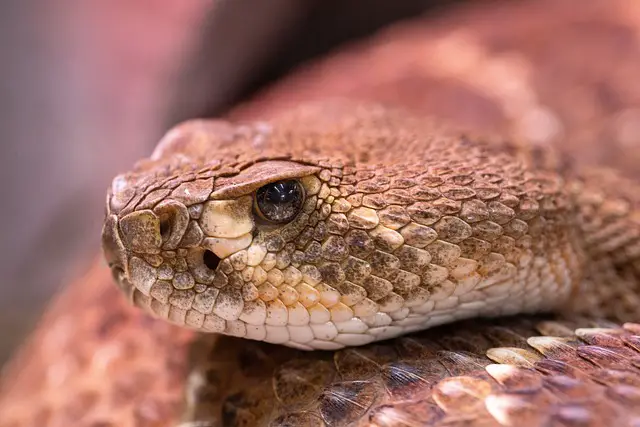Make up your mind for the most exciting rattlesnake facts for kids including rattlesnake habitat, diet, and its behavior toward other species. Rattlesnakes are a set of venomous snakes belong to the genera Crotalus and Sistrurus. These snakes are associated with the subfamily of Crotalinae. There are around 32 recognized subspecies of rattlesnakes, all of which are endemic to America, inhabiting in the British Columbia (Canada), Central Argentina, and Alberta. Rattlesnakes are the apex predators that are known to live in a variety of habitats. These reptiles consume rodents and birds by killing their prey with the venomous bite. All the rattlesnakes species have set of fangs through which they infuse a large amount of hemotoxic venom. This venom indeed passes through the blood stream thereby leading to swelling, destroying tissues, and severe internal pain. Rattlesnakes are often fall prey to weasels, king snakes, and hawks. Humans are also responsible for killing a good many number of these snakes which is why the population is threatened. Some of the unnatural causes that lead to the population decline are habitat loss and extermination campaigns. Rattlesnakes are by far the foremost causes of snake injuries all throughout North America, with an estimate of 82% of fatalities. These reptiles are not known to bite aggressively unless disturbed.
Rattlesnake Facts For Kids – Amazing and Interesting
- Rattlesnakes are carnivorous species and are known to feed on small creatures.
- The average lifespan of these types of snakes is about 10 – 20 years.
- The length of the rattlesnake measures around 1.7 meters (5.5 feet).
- These snakes weigh around 2.3 kg (5 lbs).
- The eastern diamondback rattlesnake is by far the largest venomous snake across North America, averaging 8 feet (2.4 meters), with the weight measuring at 10 pounds (4.5 kg).
- According to an estimate, more than 8,000 people are bitten by poisonous snakes in the United States each year.
- One of the strange facts about rattlesnakes is that baby rattles are apt to be more dangerous than adult snakes since they do not have any control over the amount of venom they inject.
- The size is equivalent to the 2 meters (6 feet) human.
- Rattlesnakes have two organs that can discern radiation emitted from the prey.
- The rattlesnakes are adept to hunt warm-blooded creatures at night.
- The eyes of rattlesnakes are perfectly designed so as to ensure a precise vision even at night. Having said that, rattlesnake’s eyes are not solely designed for nocturnal hunting as they can keenly visualize objects in daylight conditions too.
- These snakes perceive their prey or predator through its movement.
- They have a keen sense of smell that allows them to pick olfactory stimuli via nostrils as well as by flicking their tongues.
- Like other snakes, rattlesnakes lack external ears and their structure differs significantly as those of other vertebrates and mammals. The snakes are almost incapable to detect sounds even though they’re not deaf.
- The mature rattlesnakes shed their fangs after every 2 – 3 months.
- Rattlesnakes generally take several years to mature, and females usually reproduce only once every three years.
 Where Do Rattlesnakes Live | Rattlesnake Habitat Facts
Where Do Rattlesnakes Live | Rattlesnake Habitat Facts
True to its name, rattlesnakes have rattle located at the end of their tails which produces a loud sound that warns nearby predators or passerby. These snakes inhabit in America, ranging from Southwestern Canada and Central Argentina. Most of these species also lives in Mexico and American Southwest, with some are found in the South America and Mississippi river. The rattlesnakes are known to reside in almost all the habitats that enables terrestrial vertebrates, with few species are too limited to their habitats possibly because of their absolute association with specific plants. These snakes exist in the open areas adjacent to rocky regions since these rocks allow them to prey on different kinds of lizards, insects, and rodents. The rattlesnakes exist in forests, deserts, prairies, and marshes. They fancy their living in the temperature ranging from 80 to 90 degree Fahrenheit. They are also capable to reside below freezing temperatures.
What Do Rattlesnakes Eat | Rattlesnake Facts For Kids about their Diet
Rattlesnakes primarily prey on small creatures such as tiny birds, rats, small insects, rodents, and mice. These snakes must be accredited for limiting the increasing population of rodents thereby playing significant ecological role. These species are regarded as sit-and-wait predators.
Natural Predators of Rattlesnakes
There is an array of natural predators that prey on rattlesnakes including crows, raccoons, skunks, coyotes, weasels, kingsnakes, racers, roadrunners, opossums, and ravens. There are some smaller bird species that frequently feed on crotaline species; these birds include blue jays, kingfishers, and shrikes. Some of the other notable rattlesnake predators are hawks, eagles, feral pigs, indigo snakes, kingsnakes, and badgers.






Leave a Reply